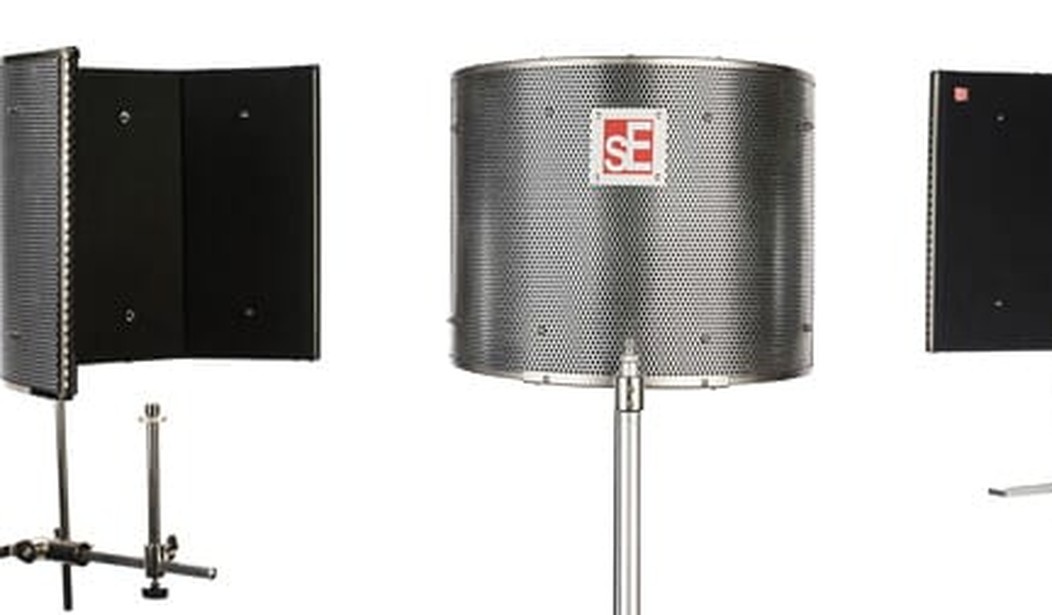
We’ll get to the strange-looking metal and foam device atop this post in a moment, but first some background material to set the stage.
Home recording is a series of trade-offs. In theory, the better the microphones you use, better your voice and instruments will sound. But the better the microphone, the more it will likely expose the sound of the room you record in. Adding permanent acoustic treatments to tame the room you record in is the safest bet, but what if that room serves double-duty as a den or bedroom?
Back in August, we interviewed Mitch Gallagher for the PJ Lifestyle blog. A couple of years ago, Gallagher, the editorial director for mail-order music giant Sweetwater, uploaded to YouTube a terrific hour-long look at how he built and acoustically treated his basement home recording studio. After discussing with him all of the elaborate lengths that Gallagher went to treat the acoustics in his basement, his interviewer David Stewart replied, “It really is vital to [treat the room before recording in it]. Sometimes what I tell people who want to get a good recording sound with microphones, is to start with the player and that’s usually the most important thing, and then the instrument, and then the next thing is the acoustics. It’s sort of in that order, in my estimation. Look, I’m VP of sales at Sweetwater. I would love to sell everybody these really expensive great microphones — and they are great — and they do sound good. And they’re going to pick up your crappy room really well, and reproduce all that nastiness really well. So boy, I just can’t say enough how important it is to go ahead and tackle those acoustic issues right away.”
And he’s right. With today’s drum loops and drum machines, sample-based software synthesizers, guitar modeling technology and digital reverbs, it’s possible to record quite serviceable sounding home music recordings, until it comes time to put the lead vocal on. But as veteran musician and tech writer Craig Anderton once wrote, “For me, the paramount lesson from doing years of studio work behind songs is that everything supports the lead singer. Your [instrumental] licks are only there to make the lead vocal more effective.”
In other words, for the vast majority of listeners of pop, rock, or melodic soul, the lead vocal is the song. It’s what makes or breaks the song, and that includes the quality of the performance, how in-tune the vocal is to its backing tracks, and not least, how well it was recorded. While it’s possible to use a dynamic such as the venerable Shure SM-58, its primary purpose is as a live mic; it lacks the high-end of the best condenser mics.
In order to facilitate a more professional approach, in recent years, small portable mini vocal booths such as the sE Electronics Reflexion Filter Pro Portable Vocal Booth (pictured above — told you we’d get to it) have appeared on the market, aimed at both musicians, and those doing voiceover work (“In a world…”) in their home studios. But do they work?
Yes, but.
The but comes from the fact that while the Reflexion Portable Vocal Booth can be a good first step to tame an unruly room, they won’t work 100 percent alone. To achieve truly dry sounding vocals in an untreated room, you’ll need to supplement the Reflexion with soft material behind the singer, such a pair of duvets. (You might also want to consider an acoustic treatment on your ceiling as well.) In his review of a similar competitor product, the proprietor of the DanceTech weblog performed yeoman work, testing the screen with and without duvets in a variety of rooms up to, as he puts it, the worst environment in most homes to record in, the tiled kitchen:
The Reflexion Portable Vocal Booth takes a bit of careful setting up; just out of the box, the rod that mates both the curved Reflexion booth and the microphone holder to the mic stand, the attaching rod that supports the Reflexion screen, the rod that holds the mic all add up initially to a bit of a Rube Goldberg feeling, until you sort out what part goes where. (The parts do serve a serious purpose: the positioning of the microphone in terms of distance from the vocal screen can be adjusted to dial in how much or how little room tone you want, and the height of the screen can adjusted vis-à-vis the relationship of the singer’s mouth to the microphone.)
This initial complexity was not aided by what seems like an obvious decision by sE Electronics to reduce their costs slightly; despite the obvious excellent craftsmanship of the underlying product, sE left a very bad initial taste in my mouth by not including instructions in the box, claiming they were reducing paper to help the environment, and instead advising me to download the manual. Gee fellas, if Gaia is in that fragile a state, should you really be speeding her demise by manufacturing all these vocal booths and mics? Fortunately, sE produced a video walking through the setup of the unit’s stand, and how the various pieces parts all bolt together.
Once assembled, I mated the Reflexion Portable Vocal Booth to a rather heavy Atlas Sound MS25E mic stand with a large 23-pound 15” triangular base. But even then, I was a bit worried that with a mic attached, there was still a slight chance the whole rig could topple over – which would not be pleasant with an expensive and delicate German condenser mic attached to the Reflexion’s business end. Just to be on the safe side, I flopped a Digital Juice sandbag left over from my video production days that weighs about 25 pounds over the front of the triangular mic stand to counterbalance the Reflexion unit.
While Jimmy Page and Keith Richards have touted the weird ambiences created in recording in offbeat locations such as England’s Headley Grange and France’s Villa Nellcôte, as Paul White, the editor of England’s long-running Sound on Sound magazine wrote in The Producer’s Manual, “sadly, back in the real world, domestic rooms and garages tend to be too small to add any usual musical ambience, meaning you’re usually better off treating them to get as dry a signal as possible, to which you can add high-quality artificial space at the mix stage using a suitable reverb unit or plug-in.”
Sophisticated sound restoration software such as Izotope’s RX5 are now capable of removing excess reverb and delay from vocal and instrument tracks, but often at the cost of leaving digital artifacts in the process. Far better to do it right each step of the way than to have to perform a lengthy salvage job or rerecord the material entirely.
The Reflexion Portable Vocal Booth is an excellent and well-made product that can help tame an unruly home recording environment. Just remember to help it along with a duvet or two behind the performer, and you can achieve surprisingly good results.










Join the conversation as a VIP Member